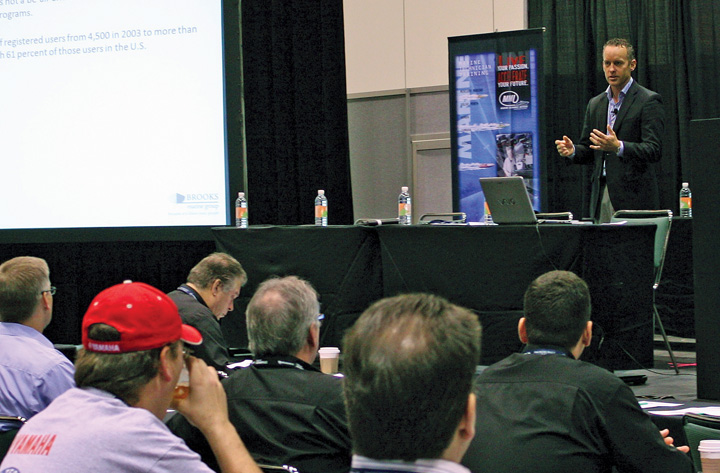State of the Industry: Hiring up, available personnel needed

The state of hiring within the marine industry is on an upward trajectory that has been building for years, and it’s time to find people to fill open positions and keep the momentum strong.
Neal Harrell of Brooks Marine Group reports its book of business is up about 50 percent year-over-year. The group has seen a steady trend of hiring growth in recent years, with 2013’s hiring also up 50 percent compared to 2012. The hiring trends are closely related to the addition of personnel instead of replacement.
All sectors of the industry in all regions of the nation are reporting growth, with some slow traffic in new large yachts construction and motor yachts, and aggressive hiring in traditional marine dealerships that have multi-faceted components such as a marina and service department. Dealerships are outpacing other hiring sectors due to the diverse jobs for which they are hiring: service technicians, sales, waterfront operations, lift crews, parts and inventory, and many more.
Harrell does not expect hiring to dip as the fall boat show season begins. Boats in winter storage programs will need service and maintenance, which creates a steady workflow throughout all regions in the industry.
“Everybody talks about the seasonality of our industry, and I think that’s a very real thing in particular parts of the country,” Harrell said, “but I really don’t believe that it affects workforce.”
A lack of personnel
Some positions have been in such demand that applicants are in short supply. Marine systems technicians – outboard mechanics, diesel mechanics, sterndrive mechanics, marine electricians and electronics technicians – are highly sought after, followed by service management.
“A lot of these organizations learned the hard way through the recession that you’ve got to have a robust service department,” said Harrell. “When boat sales taper off, service may be your lifeline.”
Recruiting and hiring has proven to be a challenge with the retiring of the baby boomer workforce – which represents 70 million individuals in the U.S. versus 40 million in Generation X – and a disappearance of the trades workforce. Some of the growth potential in the industry has stagnated due to a lack of young, trained technicians.
Harrell points to the education system in the U.S., which has focused heavily toward preparing students for college and away from trades. Individuals who may have had a curiosity about the trades were not exposed to programs or education models to promote those interests.
He suggests organizations “grow their own” workforce through partnerships with their local or state trades associations to develop programs that attract the next crop of technicians. He praises Rhode Island Marine Trades Association for their Pre-Apprenticeship Training Program, which collaborates with local technical schools, veterans’ offices and high schools to promote careers in the industry. The program offers field trips to boat yards and sells what Harrell calls “the sizzle of our industry.”
While developing these programs is a long-term investment, he firmly believes it is the best option. There are not enough trained professionals to go around and the top personnel are gainfully employed and risk-adverse due to the recent recession. Courting employees from neighboring businesses reduces employee loyalty and drives up wages, which creates a new set of problems.
Harrell says most of those currently employed would choose to stay with their employer if offered the same position for similar or higher wages, but organizations should continually show employees they are valued every day. Peer recognition and communication go a much longer way than monetary incentives. He calls it “hugging your people.”
“Don’t let the good ones get away,” Harrell said. “You have to reinforce to them how much they mean to you.”
Retaining quality employees is imperative to our industry, according to Harrell, and the loss of trades talent impacts the customer.
“If I’m a boat owner, and I can’t get access to good service because I can’t find a good technician or I can’t find a good place that provides quality repair or service, then I’m going to figure out other ways to spend my recreational time and money,” Harrell said, “ and I think that’s to the detriment of our industry.”
Harrell suggests flexibility with job requirements to alleviate the hindrance caused by the circumstances of the hiring pool. Could a must-have become a want-have? Could some of the trainings and certifications the employee needs to possess be accomplished on the job with the business’ resources?
“Looking at an individual’s upside potential versus their hard skills experience is something that I would strongly encourage organizations to do,” Harrell said.
What programs have your organization developed to attract young people and promote careers within the industry? We’d love to hear your insights and experiences in the comments section below.




